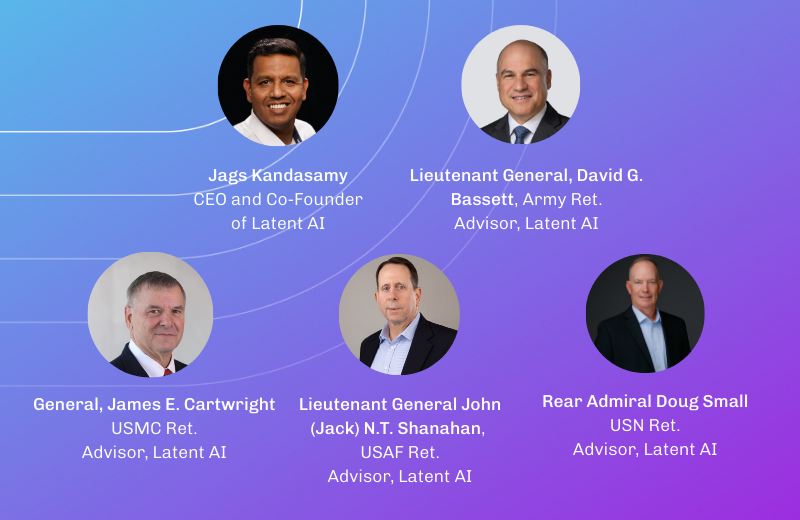AI on the edge: Transformative trend predictions for 2024
As a provider of cutting-edge technology, we empower our clients by helping them imagine how Latent AI can solve their unique challenges. Because we sit at the intersection of both federal and commercial interests, we see a variety of use cases that range from adding more capabilities to edge devices like drones to improving the quality and speed of visual inspection in manufacturing. We’ve collected some of the insights we’ve gathered from those experiences and others to guide our thoughts for the coming year. Here are the top five trends we see playing out in 2024 as faster, smaller visual AI becomes increasingly indispensable for defense, manufacturing, and more.
Decision making on the edge will become the norm
The problem is data. There’s more of it than there used to be, and more of it is coming. Processing and analysis of data is moving to edge devices like cameras, sensors, and on-premise servers because that’s the only way to keep pace with the amount of data being generated. The increasing volumes of data also means sending it to the cloud for processing will only grow more expensive while taking longer. Decisions need to occur in real-time to have the most impact. A decentralized edge approach reduces latency and lets data provide insights immediately. And by keeping sensitive information on-premise, it mitigates the risks associated with transmitting it to the cloud. The benefits and cost-effectiveness of moving models to the data for processing are simply too great to ignore.
DevOps for ML/AI becomes mainstream
Most existing tooling for ML/AI fits poorly with software engineering workflows. DevOps for ML (or AI) answers the “how” for organizations by providing the processes needed to move models from development to deployment more simply. By building automation, trust, and repeatability into the processes, DevOps for ML not only simplifies model delivery but also tackles the specialized knowledge barrier that has limited ML adoption. This shift not only streamlines the deployment of machine learning models but also lays the foundation for a more efficient, scalable, and user-friendly integration of ML.
Security impacts will grow
Building trust into results is more important than ever, notably because attack surfaces are always changing. Data poisoning, where attackers can corrupt training results with malformed data, is becoming more commonplace. Adversarial reprogramming, where a model is given a different task to perform than intended, is also a concern. Security will always need to be baked in, not brushed on, across the entire model development and deployment life cycle.
Preventing exfiltration of models and data from recovered devices is paramount for defense oriented edge ML. Models need to have security built-in with encryption to prevent data removal and watermarking that can detect tampering. On the commercial side, data privacy will become increasingly important. Currently there is a lack of universally accepted best practices or compliance standards for edge AI. That can leave gaps for attackers to slip through – via a quality control camera connected to the Internet, a vulnerability in an underlying server, or insecure development processes. Computer vision on the edge, powered by AI algorithms, is set to transform many industries, including manufacturing, healthcare, smart infrastructure/city, and many more. However, organizations should understand that a lack of compliance standards doesn’t mean there are a lack of threats to their data, intellectual property, and brand

“Baking in ML/AI expertise for non-expert users like engineers, data scientists, and operations professionals is the key for widespread adoption of edge AI.”
Widespread adoption of Edge AI means making it simpler to scale
Getting a model to run on a laptop is one thing. Getting that model to run on different hardware targets is tricky, especially for individuals from a software oriented background. So far, ML has been on the fringes because of the specialized knowledge required to make it work. We believe that developing solutions that bake in ML expertise for non-expert users like engineers, data scientists, and operations professionals is the key for widespread adoption of edge AI. Ultimately, making ML simpler to deploy at scale to edge devices is what will help industries of all kinds and sizes use their untapped data to make better and faster decisions. It’s what will help cities transform into smart cities, manufacturers improve their products and customer satisfaction, and warfighters in the field maintain a tactical advantage.
Radical new Generative AI use cases will emerge
The speed at which Generative AI has been adopted over the last year has been unprecedented. Generative AI has benefited from advancements in model development, access to the data necessary to train it, and increased computing power. However, the next wave of advancement will come in making it smaller, faster, portable, and secured. Look for radical new use cases to emerge that involve faster, smaller Generative AI applications like LLMs that can run on mobile devices for instantaneous machine translation providing real-time disconnected data analysis, and more.
Conclusion
Ultimately, edge AI and its wide range of possible applications is about making better use of the data available to us to improve our decision making. Real-time decisions require real-time processing, and that can only happen closer to the data source.
We look forward to advancing the responsible and sustainable use of AI in 2024 and beyond.
For more information about Latent AI and what we do, see: “Unlocking the Power of Edge AI“





